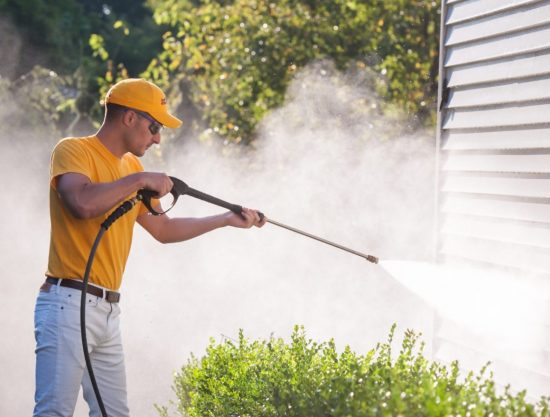
Power washing your home is one of the most effective ways to improve curb appeal, clean off built-up grime, and maintain your property’s integrity. But many homeowners make the mistake of jumping straight into the job — or hiring someone else to — without proper preparation.
The truth is, how well you prep your home before power washing can make or break your results. Not only does good prep protect your home and landscape, but it also helps ensure the cleaning is thorough, safe, and long-lasting. 🏡💧
In this article, we’ll walk you through everything you need to do before power washing your home, whether you’re tackling the job yourself or hiring a pro.
🔍 Why Prepping Is So Important
Before we dive into the checklist, let’s quickly look at why prepping is a non-negotiable step.
Proper preparation helps you:
- Prevent water from entering your home
- Protect delicate landscaping and decorations
- Avoid damage to electrical systems and lighting
- Make the cleaning process smoother and more efficient
- Minimize post-cleaning cleanup
Think of it like painting — you’d never paint over a dusty, unprepped wall, right? The same principle applies here. 🎨✅
✅ The Complete Pre-Power Washing Checklist
Here’s a full breakdown of the steps you should take before any power washing begins:
1. Inspect the Exterior of Your Home 🏠🔍
Before any water touches your home, take a slow walk around the exterior.
Look for:
- Cracked or loose siding
- Damaged window seals or caulking
- Open vents or holes where water could enter
- Rotting wood or peeling paint
- Loose gutters or downspouts
🧠 If you find any weak spots, patch or repair them first to avoid worsening damage during cleaning.
2. Close All Windows and Doors 🚪🪟
It may sound obvious, but you’d be surprised how many people forget this step — and end up with water inside their home.
Double-check:
- Basement windows
- Garage doors
- Attic vents
Use painter’s tape or weatherproof tape if you want to go the extra mile and seal sensitive seams temporarily. 💡
3. Cover and Protect Electrical Outlets and Fixtures ⚡🧯
Any exposed electrical outlet, breaker box, or light fixture can be vulnerable to water damage.
What to do:
- Cover outlets and switches with plastic and secure with waterproof tape
- Turn off outdoor circuit breakers if possible
- Cover light fixtures with plastic or a garbage bag
🚫 Water and electricity don’t mix — protect yourself and your home!
4. Remove Outdoor Furniture, Decorations, and Vehicles 🚗🪑
Give yourself (or your hired pro) room to work by clearing the area.
Move:
- Patio furniture and cushions
- BBQ grills and smokers
- Garden decorations or sculptures
- Toys, bikes, and sports gear
- Vehicles parked near the house
🏡 Pro Tip: If you have fragile or expensive items near the house (like potted plants or outdoor electronics), store them indoors temporarily.
Browse Amazon Here For Top Rated Power Washers And Accessories
5. Cover Plants and Landscaping 🌿🌸
Pressure washing detergents and high-pressure water can damage or kill plants if they aren’t protected.
Protect greenery by:
- Spraying them with clean water before and after the job
- Covering them with breathable tarps or drop cloths
- Using stakes to elevate plastic sheeting off delicate flowers
🌱 Don’t forget your garden beds and vegetable patches too!
6. Clear the Area of Debris 🍂🧹
Leaves, sticks, cobwebs, and dirt can get blasted around if left behind.
Before you begin:
- Sweep porches and walkways
- Rake leaves away from the foundation
- Remove cobwebs around windows and trim
💨 This quick cleanup step makes power washing more efficient and prevents dirty splatter.
7. Check Water Supply and Hose Connections 💧🔧
Make sure your outdoor water supply is in good shape.
Check:
- Spigot functionality and water pressure
- Garden hose condition (no leaks or kinks)
- Hose securely connected to the power washer
If you’re hiring a pro, ask if they’ll be using your water or bringing their own source. Either way, your water system should be ready to go.
8. Secure Pets and Inform Family Members 🐶📣
Power washing equipment is loud and can be startling. The last thing you want is your dog sprinting out the back door while the crew is working.
Before starting:
- Keep pets indoors or in a secure area
- Let everyone in the house know what’s going on
- Make sure doors and gates are locked or monitored
👨👩👧👦 A little communication goes a long way in keeping everyone safe.
9. Read the Manufacturer’s Recommendations (If DIYing) 📘🧰
If you’re handling the cleaning yourself, take a few minutes to:
- Read the pressure washer’s manual
- Learn about proper PSI for your siding type
- Choose the right nozzle (25° or 40° is best for home siding)
- Use approved detergents and avoid bleach unless specified
🔧 Each machine is different — knowing how yours works helps avoid costly mistakes.
💡 Bonus Tips for a Smoother Job
- Work in the shade or early morning to prevent streaking from sun-dried soap
- Use drop cloths to protect surfaces like decks or steps from detergent runoff
- If hiring a pro, walk them through your checklist and concerns in advance
✅ Final Thoughts
Power washing may seem straightforward, but skipping prep work is a rookie mistake that can lead to damage, mess, and poor results. By following this complete pre-wash checklist, you’ll make the job safer, faster, and far more effective.
Whether you’re doing it yourself or hiring someone, a little prep ensures a big payoff. Clean siding, bright trim, and a gleaming driveway are just a wash away — and now, you’re ready to do it right. 💪🧼
Browse Amazon Here For Top Rated Power Washers And Accessories



